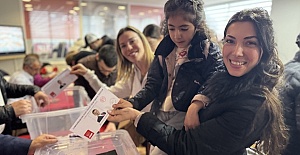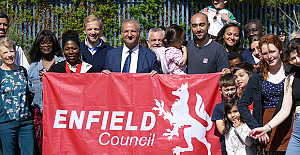SELF-HARM AND SUICIDE AMONG YOUNG PEOPLE WITHIN THE TURKISH
SPEAKING COMMUNITIES IN LONDON
By Semra Eren-Nijhar (SUNCUT)
Suicide is now one of the main causes of death worldwide and World Health Organisation (WHO) reports that in the last 45 yearssuicide rates have increased 60%. Although WHO estimates that each year approximately one million people die from suicide andself-harm, suicide isstill a taboo subjectamong all cultures and communities around the world and remainstoo, ataboo subject, in Britain.
Self-harm and suicide is a major public healthissue and also anenormous nationalsocial issue as the economic and human cost of suicidal behaviour to individuals, families, communities and society is immeasurable. Suicide is a serious problem not only in Britain but around the world as the global mortality rate of 16 people per 100,000 or one suicide death is recorded every 40 seconds.
According to the UK’s Office for National Statistics in 2011 there were 6,045 suicides by people aged 15 and over in the UK, an increase of 437 compared with 2010. It shows that the UK suicide rate increased alarmingly between 2010 and 2011, from 11.1 to 11.8 deaths per 100,000 population.
In the last eight years, self-harm and suicide became an even more alarming issue within the Turkish Speaking Communities in London. Although the number of the young people, who committed suicide within in the Turkish Speaking Communities in London, is high, the topic is still strictly taboo among the families and within the community. Some of the community organisations are aware of high rates of suicide and are trying to work on that subject by informing the local authorities or the wider community. But looking at thesuicide numbers and statistics of the young people within the Turkish Speaking Communities, immediate necessary preventative measures must be put in place.
The connection between ethnicity and suicide risk is not well understood and not much research has been conducted, and a wide reachingreport is yet to be published on the high rates of these suicide numbers. The existing information on this subjectwhich is currently in public domain is very limited and only general information exists which has been gathered from the local news media or communityorganisations. The need for accurate information has to be gathered from a cross cultural perspective.
Historically suicide rates have been the highest amongst elderly males, but new statistics show that rates among young people have been increasing to such an extent that they are now the group at the highest risk in a third of all countries, worldwide.
Looking at thesenational statistics and comparingthem with the numbers of young people from the Turkish Speaking Communities in London, who have committed suicide, the actual figures areproportionately higher,as compared to national figures.
Interestingly comparedto the statistics of the U.S. Department of Education in 2009 which show that in the US, suicide is one of the leading causes of death among young people. According to the numbers, it is the third leading cause of death among 15-24 year olds and the second leading cause of death among 25-34 year olds.
In 2009 the Centre for Disease Control and Prevention reported that almost 1 in 7 high school students (grades 9-12) reported that they had seriously considered suicide in the past year in the U.S.A.
Some new facts need to be uncovered through research and evaluated between the national statistics of suicide among young people in the States and the local statistics of suicide among young people in London for comparison, to understand the parallels or factors,if any, which push people at a young age towards committing suicide.
One crucial fact is that the risk of self-harm and suicide is especially high amongst young people of Turkish and Kurdish background within the Alevi community, approximately250.000Alevis live in London.The suicide rate within this group is the highest in London. Majority of the Alevis live in London, especially around areas such as Hackney, Haringey and in Enfield. Theavailable data show that this particular group is the most vulnerableto suicide among the ethnic communities, not only in London but also across Britain.
The hypotheses that underpins SUNCUT’s preliminary research is that the number of the young people within the Turkish Speaking Communities who committed suicide, the facts are inaccurately published and show only a fraction of the high numbers of suicides and has created a misleading and distorted picture.
Generally the global statistics confirm that the high rates of the people who commit suicide around the world are men and in the case of London, the majority of the young people who commit suicide are, boys. Here, thestatistics also shows that there are some parallels to be observed.
The suicidal behaviour among young women and girls is much higher within the Turkish Communities in Germany and in the Netherlands. In those countries compared to Britain, these statistics are equivalent to the statistics of women around the world generally that show more tendency towardssuicidal behaviour.
The reasons behind what is pushing young people to self-harm, to suicidal behaviour or to suicide within the Turkish communities in Europe have to befurther researchedbased on areas ofgender, age andreligious background (Alevi or Sunni).
In the latest WHO statistics, the rates of suicide within migrant communities such as African and East Asian Americans or the Black British community are of growing concern. In general, if compared to the wider population, Turks living in Europe have lower suicide mortality than western Europeans. Statistics in the case of Britain, or specifically from London, the numbers of the people within the Turkish Speaking Communities as compared to the wider population, the suicide mortality is disproportionatelyhigher. The high suicide rate among these young people tend to indicate that the socio-cultural factors within the community and the wider society are under researched and the notion of suicide is viewed as “abnormal” perspective within these communities.
However,it is important to mention that suicide rate can be difficult to calculate in some countries as ethnicity is not recorded on the death certificate by the authorities.This automatically reducesaccurate data capture on suicides amongst minority groups.
In the recent fieldwork undertaken by SUNCUT in this area the preliminary researchand interviews which have been conducted so far with the young people from the Turkish Speaking Communities,the preliminary data indicates that the actualnumbers are well above the officialfigures, which are publicly known. Some of the early outcomes from the individual interviews show, that many young people, against the taboo within the community,‘knew someone who has done self-harm or committed suicide, or knew someone close or related to someone who had committed suicide.’The numbers mentioned in our interviews were shockingly high. The individuals,when interviewed as part of a group were able to talk about the problems amongst young people being faced within the community or in the wider society. They were not new or strangers to this subject and in fact werevery familiar and were able to talk about the seriousness of the suicide issue amongst their peer group.
According to the young people who were interviewed individually, the subject of self-harm and suicide are not widely discussed and the families are not able to understand the wider issues underlying this problem. The interviewees said that there is lack of understanding bytheir families and communities about the issues young people face,not only within their own communitybut also within the wider society. They have mentioned the language barrier of their parent’s generation and the lack of understanding of different cultures they live within and confronted on daily basis,istheir reality.
Some of the interviewee’s cited that their parents‘generation’ want to have perfect children without puttingin any effort and time during their children’s adolescenceand continuing to send them to school is often enough to be good parent.
The most common remarkswere that, their parent’s generation are often focused more on what other people may say within their own community about their children, than what they think of their own children. The opinion of ‘the others’are always dictating, how their children should be like or behave. Young people feel the pressure and cut out the small dialogue they have with their parents due to this reason. Some of the young people mentioned that their parents live in their own world and do not know the basic needs of their children and the multi layered lives they live.
The social issues faced by young people are not heard at home or sometimes even at school. They feel isolated and lonely and in some extreme cases they join gangs for ‘recognition, to be loved and to be respected’.
Some young people believe that one of the reasons so many boys commit suicide within the community is often related to neglect. Parents do not follow up what their children do during the day and when suddenly they get involved in criminal activities, the parents see their children as a ‘failure’ and blame their child for letting them down in the eyes of their community. ‘What other people think’ is always very important to their parents and they have high expectations of them.
According to some interviewee’s,who personally knew some of the boys who hadcommitted suicide had left messages behind for their parents ‘that they failed as a child and were not good enough for them’. The high expectations of the parents from their children, builds up pressure on young people, whichbecomes very difficult to deal or cope with.
To tackle the issue, some of the young people are of the opinion that a young person should be equally responsible for the life they live and should feel equally responsible for their actions and for takingon responsibilities. They suggested even asit can often be very difficult, individual challenges can sometimes lead the parents towards the right path and better understanding between the two generations.
The most common articulation from this group of young people was the message to their parents and the community that they ‘should listen to them and improve their dialogue with them’. They all believe ‘through good communication there is nothing which can’t be achieved or resolved.’
The young people often see the good effort of the community organisations to do something positive about their young people within the community, but often fail to involve or listen to them.They think that the community organisations are instead seeking a ‘quick fix’ for other problems and are focusing more on external misguidedfactorssuch as drugs or getting involved with gangs.
The clear disconnect between the voice of the community organisations and the voice of young people within that community should be aligned together for better understanding of the causes behind what pushes young people to self-harm or to commit suicide. As these two issuesare related to each other, it should be tackled together and if necessary, measures should be aimed by raising public awareness of these issues.
Self-harming patterns of behaviour and especially repeated self-harming can be seen as an act of releasing suppressed negative emotions based on interpersonal conflicts with family members, peers or amongst gang members.
The need for developing suicide prevention strategies for a specific minority group, especially for young people within the Turkish Speaking Communities in London, is urgently required.
Whether by tackling this subject throughworking with the community organisations, with the police, with the local authorities, schools or family members; one thing has to be kept in mind are the challenges of living in a multicultural City such as London. Along with its diversity the ethnic point of view should be taken into account. According to SUNCUT’s preliminary research findings, young people from more vulnerable communities sometimes want to achieve quick success, fame or become rich without any grounding in education or regular participation in the society they live in and without any formof accomplishing actions, responsibility and behaviour.
The influence of the family on adolescents' acculturation, ethnic identity, their achievementsand psychological mind set should be taken into account when researching this subject area. The complex relationship between how parents relate to their native, as well as to the host culture has an important part to play and the impactit has on adolescents' ethnic identity, achievements and their psychological well-being.
To reduce the causes and the number of incidents of self-harm and suicide in thishigh risk group such as the young people within the Turkish Speaking Communities proactive measures should be established, to raise an awareness which promotes good quality of understanding of these issues, of their causes and educating the public and similarly the authorities and agencies more widely.
The development and adoption of coping skills and healthy decision making andaddressing self-esteem issues will contribute in the reduction of the risk of self-harm and suicide among London’s young people within the Turkish Speaking Communities.
11 November 2013, London


 Prime Minister Keir Starmer's 2025 Easter message
Prime Minister Keir Starmer's 2025 Easter message After Nesil Caliskan a by-election will be held in Jubilee ward in Enfield
After Nesil Caliskan a by-election will be held in Jubilee ward in Enfield Publishing the analysis, Labour’s Cllr Ergin Erbil said Everybody in Enfield deserves basic rights
Publishing the analysis, Labour’s Cllr Ergin Erbil said Everybody in Enfield deserves basic rights Gaza-Israel conflict Statement from Cllr Ergin Erbil, Leader of Enfield Council
Gaza-Israel conflict Statement from Cllr Ergin Erbil, Leader of Enfield Council UK AMBASSADOR TO TURKEY VISITS FETHIYE
UK AMBASSADOR TO TURKEY VISITS FETHIYE Journalists from Europe held the Turkish Media Workshop in Skopje
Journalists from Europe held the Turkish Media Workshop in Skopje The European Union called on Turkey to uphold democratic values
The European Union called on Turkey to uphold democratic values Turkish citizens in London said Rights, Law, Justice
Turkish citizens in London said Rights, Law, Justice The 'Prince of Paris' has impressed in his first EuroLeague season
The 'Prince of Paris' has impressed in his first EuroLeague season Saran Media And Euroleague Basketball Extend Media Rights Partnership for Four More Years
Saran Media And Euroleague Basketball Extend Media Rights Partnership for Four More Years Will Rangers be Jose Mourinho’s next victim?
Will Rangers be Jose Mourinho’s next victim? Jose Mourinho's Fenerbahce face Rangers on Thursday
Jose Mourinho's Fenerbahce face Rangers on Thursday Residents welcomed back to Edmonton Leisure Centre
Residents welcomed back to Edmonton Leisure Centre Barclays has become the biggest UK lender so far to cut mortgage rates
Barclays has become the biggest UK lender so far to cut mortgage rates THE SPRING STATEMENT EXPLAINED, UK ECONOMIC OUTLOOK AND GROWTH FORECASTS
THE SPRING STATEMENT EXPLAINED, UK ECONOMIC OUTLOOK AND GROWTH FORECASTS Launch of Made in Enfield gift shop to celebrate local artists and designers
Launch of Made in Enfield gift shop to celebrate local artists and designers




















